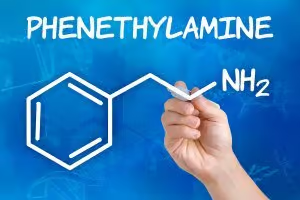Table of Contents
Key Takeaways
- Phenylethylamine (PEA) is a trace amino acid with stimulant and mood-enhancing effects, synthesized from L-Phenylalanine and found in certain foods and chocolate.
- PEA activates TAAR1 and TAAR2 receptors, leading to increased serotonin and dopamine release, potentially helping with anxiety, depression, and ADHD.
- Aging can lead to decreased PEA levels, which may be linked to ADHD, addiction, and neurodegenerative diseases.
- PEA shows promise as an antidepressant and a potential alternative to SSRIs, with ongoing studies for ADHD treatment.
- PEA has a short half-life, which can be extended by using it with a MAO-B inhibitor, and potential side effects include the “cheese effect” and other amphetamine-class side effects.
Phenylethylamine (PEA, 2-phenylethylamine, beta phenylethylamine / β-phenylethylamine, phenethylamine) is a trace amino acid. Your brain naturally converts L-Phenylalanine into Phenylethylamine (PEA).
PEA is not at the top of most nootropic stack choices because its effects are so short-lived. But some neurohackers love PEA for its stimulant and mood enhancing qualities.
The most famous promoter of phenylethylamine was Dr. Alexander Shulgin and his wife Anna. Dr. Shulgin published ‘PiHKAL: A Chemical Love Story’ in 1991. PiHKAL is short for “Phenethylamines I Have Known and Loved”.
Phenylethylamines are a group of phenethylamine derivatives which contain PEA as a backbone. These derivative compounds are formed by replacing one or more hydrogen atoms in the core structure.
This class of PEA compounds include amphetamines, empathogens, stimulants, psychedelics, appetite suppressants, bronchodilators, nasal decongestants, and antidepressants.
One of the more famous PEA derivatives is Methylenedioxymethamphetamine (MDMA or Ecstasy).
Dr. Shulgin developed, tested, and published the formulas for 179 different compounds largely based around the structure of PEA in his book PiHKAL.
In this review we investigate how phenylethylamine (PEA) works in the human brain.
Phenylethylamine helps:
- Anxiety & Depression. PEA activates TAAR1 and TAAR2 receptors which in turn prevents the uptake and boosts the release of the ‘feel-good’ neurotransmitters serotonin and dopamine.
- Neuroprotector. Monoamine oxidase inhibits the catecholamines like dopamine and norepinephrine. Decreases in dopamine levels are implicated in diseases like Parkinson’s. PEA helps boost dopamine and norepinephrine levels. Reducing the symptoms of neurodegenerative diseases.
- Attention Deficit Disorder (ADHD). PEA prevents the reuptake of dopamine and norepinephrine and inhibits their transport. Like the mechanism of action provided by ADHD stimulant meds. Some have found supplementing with PEA as a nootropic has decreased the symptoms of ADHD.
Overview
Phenylethylamine (PEA, 2-phenylethylamine, β-phenylethylamine, phenethylamine) is a trace amine naturally synthesized from L-Phenylalanine in your brain that links to your brain’s trace amine-associated receptor.

Aromatic amino-acid decarboxylase converts phenylalanine to phenylethylamine. This is the same enzyme that converts phenylalanine into dopamine. And it converts it at a rate comparable to the synthesis of dopamine.
But PEA is not retained in neuronal vesicles like dopamine is stored. Instead, monoamine oxidase-B (MAO-B) quickly degrades PEA.[i]
Despite its short half-life, PEA as a nootropic seems to be effective for increasing catecholamine activity by boosting dopamine and norepinephrine.[ii]
PEA can be found naturally in many cacao, algae, fungi, and bacteria as well as clover, beans, peas, and some food products such as Natto and eggs.
PEA is also found in chocolate where it is produced during cacao’s fermentation and roasting process.[iii]
PEA binds to C-protein-coupled receptors TAAR1 and TAAR2, receptors reserved specifically for trace amine use.[iv] These receptors are not used by other major neurotransmitters like dopamine or norepinephrine.
The half-life of PEA taken as a nootropic supplement is only 5 – 10 minutes.[v] Because it’s quickly degraded by monoamine oxidase-B (MAO-B).
Many neurohackers prolong the effects of PEA by using it with a monoamine oxidase-B inhibitor (MAOI) like selegiline (L-Deprenyl), hordenine, or Oat Straw.
How does Phenylethylamine work in the brain?
Phenylethylamine boosts brain health and function in several ways. But two in particular stand out.
- Phenylethylamine decreases depression. PEA naturally boosts the ‘feel-good’ neurotransmitters in your brain called serotonin and dopamine. Studies have shown that depressed patients when tested have lower levels of PEA.[vi]
In fact, some suggest that a PEA deficit may be the cause of depression in the first place. One study had 14 patients with major depression take up to 60 mg per day of Phenylethylamine (PEA) along with 10 mg of selegiline (L-Deprenyl) for up to 50 weeks.
Researchers found that “PEA produces sustained relief of depression in a significant number of patients, including some unresponsive to the standard treatments. PEA improves mood as rapidly as amphetamine but does not produce tolerance.”[vii]
- Phenylethylamine is a mesencephalic enhancer. PEA is considered a mesencephalic enhancer which is defined as “enhancer-sensitive neurons in the brain capable of working in a split-second on a high activity level due to endogenous enhancer substances”.[viii]
This means that PEA stimulates the release of dopamine, norepinephrine, and serotonin in the brain. But unlike stimulant drugs like amphetamine, which release a flood of these neurotransmitters in an uncontrolled manner.
PEA instead only increase the amount of neurotransmitters that get released when a neuron is stimulated by receiving an impulse from a neighboring neuron.
In other words, the pattern of the neurotransmitter release in not changed. But when the neuron would normally release a neurotransmitter, a larger than normal amount is released.[ix]
The result is nearly instantaneous improvements in cognitive performance, attention, awareness, pleasure, libido, and a sense of well-being.
Phenylethylamine is an endogenous (natural or ‘built-in’) amphetamine. This mechanism of action is how prescription ADHD stimulants like Adderall work. And the basis for many Schedule 1 drugs like MDMA[x], LSD, mescaline, and (crystal) methylamphetamine.[xi]
How things go bad
Phenylethylamine (PEA) is naturally metabolized by monoamine oxidase-B (MAO-B). But as we get older, MAO-B levels rise and suppress healthy levels of PEA.
Low PEA levels have been linked to several neurological diseases. And may result in:
↓ Increased chance of ADHD
↓ Increased chance of addiction
↓ Energy levels decline
↓ Working memory and mood decline
↓ Contributing to Parkinson’s Disease
On the other hand, excess levels of PEA has been linked to migraines and paranoid schizophrenia.
Phenylethylamine central nervous system benefits
Phenylethylamine (PEA) quickly crosses the blood-brain barrier once you take it. And you feel its effects right away.
 Activation of TAAR1 receptors inhibit the uptake and induces the release of dopamine, norepinephrine, and serotonin. It’s like turning up the volume of neuron activity.
Activation of TAAR1 receptors inhibit the uptake and induces the release of dopamine, norepinephrine, and serotonin. It’s like turning up the volume of neuron activity.
A higher concentration of all of these neurotransmitters increase feelings of pleasure, boosts motivation, improves memory and cognition, and reinforces impulse control.
PEA naturally maintains and regulates neuronal activity. Preventing over- or under-stimulation. When working as designed, PEA and other trace amines prevent metabolic dysfunction and neurological disorders.
As a neurotransmitter, PEA acts like, and looks similar to amphetamines. And produces effects normally associated with taking a stimulant (like the drug amphetamine Adderall). But unlike amphetamines, and because PEA is endogenous to the brain, side effects and tolerance are avoided.
PEA works in an area of the brain associated with emotions. Resulting in feelings of pleasure, more drive and impulse control, heightened creativity, and better sensory perception.
PEA improves libido, social behavior, a sense of wellbeing, and better overall performance.
PEA is currently being studied and used for the treatment of ADHD, depression, bipolar disorder, cognitive dysfunction like brain fog and poor concentration. And PEA looks promising for treating addiction and eating disorders.
How does Phenylethylamine feel?
PEA is rapidly broken down by monoamine oxidase-B (MAO) so unless you stack PEA with a brain chemical like a MAO-B inhibitor, don’t expect its effects to last. Most experience a peak within 15 minutes and sustained energy for 30 min. to an hour.
If you’re ADHD or ADD, you should see an improvement in mood, attention span, focus and mental clarity. Not quite the same effect you’d get from something like Adderall but with a side benefit of more sociability.
Neurohackers report taking a monoamine oxidase inhibitor (MAOI) supplement 15 minutes before a PEA dose and the effects should last about 2 hours. And there’s no crash like you’d normally experience with a stimulant. Just a general feeling of well-being once it wears off.
Some have reported PEA helped kick the habit of Phenibut or caffeine without going through withdrawal.
As a pre-workout supplement, PEA provides a more intense and focused workout.
Older neurohackers seem to feel even more benefit when using PEA. Likely because monoamine oxidase levels over-power dopamine the older you get. And using PEA, especially with a MAOI helps restore dopamine, the brain chemical called serotonin, and other neurotransmitters that are typically depressed with age.
PEA is a great nootropic for study because you should feel less anxiety, fewer panic attacks and less stress. And more motivation, a better mood, easier to maintain focus, and more energy.
Some report food cravings subside and it’s easier to lose weight.
Phenylethylamine Clinical Research
Phenylethylamine as an Antidepressant
Depression is the 2nd leading cause of disability among ages 15 – 44. By 2030, the World Health Organization predicts depression will be the leading cause of disability worldwide.[xii]
Selective serotonin reuptake inhibitors (SSRI) are the most popular antidepressants prescribed worldwide. SSRIs work by blocking the serotonin transporter and inhibiting the reuptake of the neurotransmitter in your brain called serotonin. Resulting in an increase of serotonin in synapses.
But the problem is SSRIs are slow to act. And come with a host of side effects. The sustained antidepressant effect of Phenylethylamine (PEA) may be an alternative to SSRIs.
A study done in 2008 showed that PEA alters serotonin transporters by interacting with TAAR receptors. Increasing serotonin levels by preventing their reuptake just like prescription SSRIs.
The study suggested that PEA may be a safer treatment for depression than SSRIs.[xiii]
Phenylethylamine for ADHD
The diagnosis of attention deficit hyperactivity disorder (ADHD) has traditionally been done by analysis of symptoms. But measuring PEA levels instead has recently been described as a possible biomarker for diagnosing ADHD.[xiv]
This discovery of a relationship between PEA levels and ADHD has excited researchers. Because it will hopefully improve levels of confidence during ADHD diagnosis. And reduce misdiagnosis and over-medication.
One study of ADHD children medicated with methylphenidate (Ritalin) had significantly higher PEA levels when using methylphenidate.[xv]
PEA binds to the TAAR1 receptor which alters monoamine transporter function. And leads to the inhibition of the reuptake of dopamine, serotonin, and norepinephrine. Which then increases the concentration of these neurotransmitters in neuron synapses.[xvi]
This increase in synaptic concentrations of dopamine can be accomplished by directly blocking the dopamine transporter. Which is how drugs like methylphenidate work to boost dopamine.
So if you are ADHD and crave chocolate, it’s likely because cocao supplies PEA.
Some naturopaths are beginning to prescribe PEA instead of stimulants like amphetamines or methylphenidate to treat ADHD.
Phenylethylamine Dosage
 Phenylethylamine (PEA) suggested dosage for cognitive benefit is 500 mg up to 3-times per day.
Phenylethylamine (PEA) suggested dosage for cognitive benefit is 500 mg up to 3-times per day.
PEA has a half-life of 5 – 10 minutes.[xvii] But the effects of PEA can be extended by using it with a MAO-B inhibitor.
If you do use a potent MAOI like selegiline (l-deprenyl) make sure you keep the dose low (i.e. 2.5 mg) or you’re in danger of inhibiting MAO-A as well. More on the “cheese effect” next.
Dosing more than recommended is NOT a good idea because you’ll likely feel jittery, irritable, get a headache, feel nausea, and very possibly force your heart rate to dangerous levels.
Phenylethylamine Side Effects
“Cheese effect”: Phenylethylamine (PEA) is metabolized by the enzyme MAO-B. And when monoamine oxidase (MAO) is inhibited by eating cheese, or any other prescription or natural MAO inhibitor (MAOI), the combination can result in a potentially dangerous increase in blood pressure.[xviii]
Studies show that selective MAO-B inhibition does NOT produce this cheese effect.[xix]
Examples of MAO-B selective inhibitors include low-dose selegiline (L-deprenyl), hordenine, Polygala Tenuifolia, Oat Straw, Glycyrrhiza uralensis (Chinese licorice root extract), Phellondendron amurense (Amur cork tree bark), Ferula assafoetida extract (resin), and Psoralea corylifolia (Bu Gu Zhi).[xx]
Do not use Phenylethylamine (PEA) if you are using a prescription MAOI like Marplan, Nardil, Azilect or Parnate, or have used one in the last 14 days.
Do not use PEA if you have phenylketonuria (PKU).
Too much PEA can cause irritability, nausea, amplified heart rate, jitteriness, and could be extremely dangerous.
Remember, Phenylethylamine (PEA) is a (natural) endogenous amphetamine. And used irresponsibly could produce the same dangerous side effects as anything else in the amphetamine-class of compounds.
Where to buy Phenylethylamine
Phenylethylamine (PEA) is available in capsules, tablets, and as a bulk powder.
DO NOT make the mistake of buying Phenylalanine instead of Phenylethylamine (PEA). Because it’s NOT the same thing. And is easily overlooked when searching for this nootropic.
You can buy Phenylethylamine in powder form from Bulk Supplements.
If you buy PEA in powder-form, you should invest in a capsule machine and make capsules. Because PEA is a particularly nasty tasting nootropic supplement.
Nootropics Expert Recommendation
 Phenylethylamine 500 mg up to 3-times per day
Phenylethylamine 500 mg up to 3-times per day
I recommend using Phenylethylamine (PEA) as a nootropic supplement.
Your body does synthesize some Phenylethylamine from phenylalanine which comes from foods like beans, cacao, peas, Natto and eggs.
But most of us don’t get enough Phenylethylamine from our diet. So supplementation could help. Phenylethylamine is highly bioavailable, and quickly crosses the blood-brain barrier. So you should feel its effects soon after you take it.
Phenylethylamine is helpful for most neurohackers to combat anxiety, stress, and sleep deprivation. It’ll boost dopamine, norepinephrine, and serotonin levels.
It’s particularly helpful if you take Phenylethylamine prior to a stressful situation, workout, or physically demanding job. And it’s a great nootropic for studying.
Phenylethylamine could be helpful to those dealing with ADHD/ADD. It’s a possible substitute to stimulant meds like Ritalin or Adderall for some people.
PEA will provide the dopamine your brain needs. And doesn’t produce the stimulant crash when it wears off.
PEA works well when stacked with L-Tyrosine (for dopamine), and CDP-Choline and ALCAR (for acetylcholine).
PEA is quickly degraded by monoamine oxidase-B. So to prologue its effects, stack it with a low-dose MAOI-B.
You can buy Phenylethylamine in powder form from Bulk Supplements.









Join The Discussion - 188 comments
Luc
March 22, 2021
I’m always puzzled about which nootropics should be taken on an empty stomach. Does it matter with PEA? And ALCAR and NALT ?
David Tomen
March 23, 2021
Luc, the only rational for taking a supplement on a empty stomach is if it’s an amino acid. And you don’t want it competing for the same transporters as the amino acids in your food.
I avoid taking anything with food because I ensure the fat-soluble ingredients in my stack are digested and used by taking a tablespoon of unrefined coconut oil each time I take my stack.
David
June 9, 2021
Woooaaah i e just taken a handful of these in capsule form and having an amazing euphoria – also I am adhd and my memory and concentration has markedly improved over four days. I write and make music, and this, alongside a little DMAE is just awesome.
Greg P Hodes, Ph.D
March 11, 2021
Dave, I am a chronic depressive who has been using moderate doses of Pea.
1). I’ve done some careful research on PEA and cognition (working memory, complex-choice reaction time and variability, processing speed, fine motor control, etc.) using myself as a control (I know how to do this). I found that at doses at which I began experience even a slight “high” cognition began to . Lower doses produced small gains on some tests, but erratically.
2.) In my case, at least, PEA produces an unpleasant odor. Can this be prevented.
3) I’ve been taking modest doses of PEA with selegiline 5-7mg in divided doses for years with no know negative side effects.
David Tomen
March 12, 2021
Dr. Hodes, unfortunately there’s not much you can do about the “unpleasant odor” because that’s how PEA smells: https://pubchem.ncbi.nlm.nih.gov/compound/Phenethylamine#section=Color-Form (scroll down to the section called “odor”).
John
March 2, 2021
Hi Dave, is there a reliable brand that you recommend for Phenylethylamine?
Thanks,
John
David Tomen
March 2, 2021
John, this one is pure with no “other ingredients”: https://amzn.to/3bThTvw
Dave
September 27, 2022
Hi David,
I too am trying to find a good source for Phenylethylamine. I clicked on the link you provided and for some reason the link is broken. Can you provide another link?
Thanks,
John
David Tomen
September 28, 2022
John, I did not have a link for Phenylethylamine but have just found a source and updated my “Where to buy” section. Take a look above.
Jay
February 23, 2021
Hi Dave, really informative article! Is the 500mg 3x per day dosage of pea just for people with Alzheimer’s who have severe cognitive issues? Or is it’s also for people with depression and anxiety also? I’m about to try it for depression and anxiety. I have just started oat straw and am waiting for phenylethlamine to arrive. I’m having good results with just oat straw on its own already.
David Tomen
February 24, 2021
Jay, that dosage is for anyone using this nootropic.
Joshua R
February 23, 2021
I was looking into PEA and came across Eria Jarensis Extract (N-Phenethyl-Dimethylamine Citrate. What is the difference between the two? The Eria Jarensis say’s it can last 4 hours with it peaking after 90min.
David Tomen
February 23, 2021
Joshua, I’m not familiar with it. Do they have any proof that it lasts longer?
Olivier
January 17, 2021
Hello Expert 🙂
I would like to Try pea with maoi hordenine or oat straw. It is why i am asking some questions…
What are the risks of an excess of pea in brain, and what dose it is ?
What are the effects, combined with alcohol ?
What are the dosage of pea with hordenine or oat straw for a first experience ?
Thank you a lot if you have these informations.
David Tomen
January 17, 2021
Olivier, Phenylethylamine (PEA) suggested dosage for cognitive benefit is 500 mg up to 3-times per day.
Too much PEA can cause irritability, nausea, amplified heart rate, jitteriness, and could be extremely dangerous. “Too much PEA” is anything over 1500 mg per day.
No idea what the risks of PEA is with alcohol. But I imagine it’s not good.
Dosage for Oat Straw extract is 300 mg for each PEA dose. I’m not familiar with Hordenine so can’t comment.
Brandon S.
January 12, 2021
I can personally say DO NOT combine Phenethylamine (PEA) with Parnate (MAOI). I did this many years ago and had a hypertensive crisis. I seriously almost DIED from combining the two. My Face was bright red and my head was pounding. It took about two hours for it to go away and I really should’ve gone to the ER. I had a full blown and paranoia panic attack. The pain was intense!
I had a headache that lasted me about a week. It was my dumb mistake for not listening and doing research. Long story short don’t combine Phenethylamine with prescription MAOIs (Parnate)
LAWRENCE
February 20, 2021
When you are any MAOI inhibitors, like L Deprenyl, you are supposed to cautious about eating tyramine rich foods such as wine and cheese, so I wuold be definitely careful about combining with any supplements.
Alexandra
December 30, 2020
Hi there, hoping someone will see this! I’m planning to try the PEA/oat straw combo, but haven’t been able to find specific dosing info for the oat straw. I see that as a natural MAOI it needs to be “low”, but would love a better idea of what that means.
Also, if the PEA is taken multiple times a day, does the oat straw need to be taken prior to each PEA dose, or just before the first one? Thanks so much! This info was incredibly helpful for me, and I’ll be trying this before I consider Adderall.
David Tomen
December 31, 2020
Alexandra, people use MAOIs with PEA to prolong its effects. So you do not need to dose it as many times per day.
I suggest starting with 350 mg Oat Straw each time you use PEA but no more than 3-times per day. In other words, if you’re doing PEA 5-times per day you’d only do Oat Straw 3-times per day. Evenly spread out during the day (i.e. morning, noon and late afternoon).